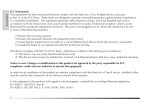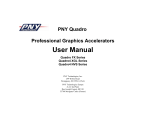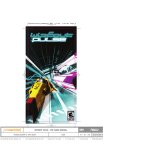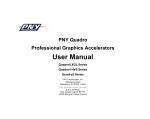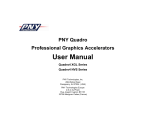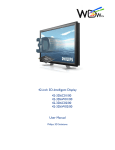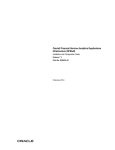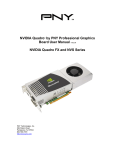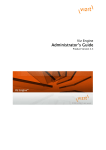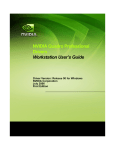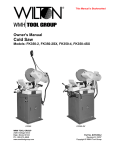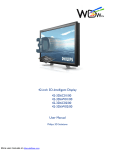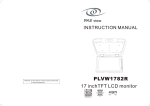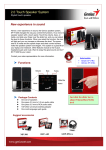Download User Manual
Transcript
PNY Quadro Professional Graphics Accelerators User Manual Quadro FX Series Quadro NVS Series PNY Technologies, Inc. 299 Webro Road Parsippany, NJ 07054 (USA) PNY Technologies Europe Z.A.C du Phare Rue Joseph Cugnot, BP-181 33708 Merignac Cedex (France) PNY Quadro User Manual Rv. 0619 - V. 3.0 page 1 Table of Contents Chapter 1 - Introduction ................................................... 3 Chapter 2 - Hardware Installation................................... 6 Chapter 3 - Software Installation ................................... 20 Chapter 4 - nView™ Installation ................................... 22 Chapter 5 - Display Properties ....................................... 34 Chapter 6 - MAXtreme ................................................... 63 Chapter 7 - POWERdraft ............................................... 65 Chapter 8 - Technical Support / Warranty .................... 67 Limited Liability The information contained in this manual has been validated at the time of manual production. The manufacturer reserves the right to make any changes, additions and revisions to the product described in this manual at any time and without notice. Consequently, PNY Technologies, Inc. assumes no liability for damages incurred directly or indirectly from errors, omissions or discrepancies between the product and the manual. Copyright and Trademarks Copyright ©2006 PNY Technologies, Inc. All Rights Reserved. PNY, PNY Technologies and the PNY logo are registered trademarks of PNY Technologies, Inc. NVIDIA, the NVIDIA Logo and NVIDIA Quadro are trademarks or registered trademarks of NVIDIA Corporation in the United States and/or other countries. All other trademarks & logos are the property of their respective companies. PNY Quadro User Manual Rv. 0619- V.4.0 page 2 Chapter 1 Introduction Congratulations on the purchase of your Quadro graphics accelerator board from PNY Technologies. You are now the owner of a state-of-the-art graphics accelerator that was designed for professional 3D and 2D applications, and offers features and functionality beyond any other card in its class. We recommend that you read through this User Guide before installing your accelerator board to ensure a proper installation. Minimum System Requirement • • • • • • • IBM® or 100% PC compatible with genuine Pentium® III or AMD Athlon® class processor or higher One available PCI-Express slot, or one available PCI slot Windows® 2000, Windows® XP or Windows® XP 64 with latest Service Pack or Linux 256 MB system memory 80 MB of available disk space for full installation CD-ROM or DVD-ROM drive VGA or DVI-I compatible monitor Package Contents PNY Quadro User Manual Rv. 0619- V.4.0 page 3 Please check your package, which contains the items below. If you find any damaged or missing items, please contact your dealer. • • • • • • • • • Graphics board 1x DVI-I to VGA adapter (PNY Quadro FX 350, Quadro FX 540) 2x DVI-I to VGA adapters (PNY Quadro FX 550, Quadro FX 560, Quadro FX1400, Quadro FX 1500, Quadro FX 3450, Quadro FX 3500, Quadro FX4500, Quadro FX 4500G, Quadro FX 5500, Quadro FX 5500G) 4x DVI-I to VGA adpaters (PNY Quadro FX 4500 X2) 1x DMS59 adapter to 2x VGA + 1x DMS59 adapter to 2x DVI-I (PNY Quadro NVS 280, Quadro NVS 285) 2x DMS59 adapters to 2x VGA + 2x DMS59 adapter to 2x DVI-I (PNY Quadro NVS 440) Additional Power Supply cable (PNY Quadro FX 3450, Quadro FX 3500, Quadro FX 4500, Quadro FX 4500G, Quadro FX4500X2, Quadro FX 5500, Quadro FX 5500G) CD-ROM: software drivers for Windows® 2000, Windows® XP, Windows® XP 64 and Linux® 32/64 Installation Guide PNY Quadro User Manual Rv. 0619- V.4.0 page 4 Before You Begin • Before installing the Display driver, make sure your Windows® 2000, Windows® XP or Windows® XP 64 was installed in VGA mode and functions properly. IMPORTANT Uninstalling Your Existing VGA Driver • • • • Remove your existing Display Driver using the Add/Remove Icon in ‘Control Panel’ Shut down your computer. Remove your existing video card NOTE: If your system (motherboard) has an onboard graphics controller, please contact the system vendor on how to properly disable it. PNY Quadro User Manual Rv. 0619- V.4.0 page 5 Chapter 2 Hardware Installation IMPORTANT Static electricity can severely damage electronic parts. Please take these precautions when installing your graphics card: • Before touching any electronic parts, discharge the static electricity from your body by touching the internal metal frame of your computer while it is unplugged. • Do not remove a card from the anti-static container it shipped in until you are ready to install it. Whenever you remove a card from your computer, always make sure to place it back in its container. • Do not let your clothing touch any electronic parts. • When handling a card, hold it by its edges, and avoid touching its circuitry. Preparing Your Computer for Installation Prior to working on your computer, make sure the power of the computer and any attached equipment such as a monitor or printer is turned off. Unplug your computer and remove the cover. Remove your current graphics card. For systems with ‘On-Board 3D Graphics’, there is no graphics card to remove. Some systems may require you to disable your ‘On-Board 3D Graphics’. Consult your PC users’ manual or vendor manual on how to properly do this. PNY Quadro User Manual Rv. 0619- V.4.0 page 6 Selecting the Proper Expansion Slot Most computers have a combination of PCI-Express x16, PCI-Express x8, PCI-Express x4, PCI-Express x1 and PCI expansion slots. All these slots may look similar at first; however you will notice their differences once you examine them more closely. The PCI-Express slots on your computer motherboard are usually the closest connectors to the CPU. The PCI connectors are usually the farthest connector to the CPU. The PCI connectors are made from a white plastic, and are the same connector type that most Sound or Modem Cards are connected. If you are still unsure which connectors PCI-Express and PCI, consult your system manual to help you identify them. Plugging your graphics card into an incorrect slot could damage the card, your computer, or both. Do not try to force a card into a slot that does not accommodate it, as it is probably the wrong slot. PNY Quadro Boards list by expansion slots to be used: PCI-Express x16 PCI-Express x1, x4, x8 PNY Quadro NVS 285 PCIE x16 PNY Quadro NVS 285 PCIE x1 PNY Quadro NVS 440 PCIE x16 PNY Quadro NVS 440 PCIE x1 PNY Quadro FX 350 PNY Quadro G-Sync PNY Quadro FX 540 PNY Quadro FX 550 PNY Quadro FX 560 PNY Quadro FX 1400 PNY Quadro FX 1500 PNY Quadro FX 3450 PNY Quadro FX 3500 PNY Quadro FX 4500 PNY Quadro FX 4500X2 PNY Quadro FX 5500 PNY Quadro G-Sync The diagram below should help you in identifying the proper slot. PCI PNY Quadro NVS 280 PCI PNY Quadro G-Sync Motherboard Example with PCI-Express PNY Quadro User Manual Rv. 0619- V.4.0 PCI-Express x1 Slots (3) PCI-Express x16 Slot page 7 Inserting Your Graphics Card Remove the back of the PC cover for the slot you intend to use and save the screw for the mounting bracket of your new PNY Quadro graphics card. Position the Quadro graphics card over the expansion slot that coincides with the type (PCI-Express or PCI) of card purchased. Push the card firmly and evenly until it’s fully seated into the slot. Replace the screw to secure the bracket of the graphic’s card to the computer chassis. Replace the cover of your computer. Plug your Monitor (CRT) or Flat Panel (TFT) Display cable into the appropriate connector on your graphic card. All cables MUST be connected before your computer is powered on. PNY Quadro User Manual Rv. 0619- V.4.0 page 8 Additional Power Requirements (PNY Quadro FX 3450, FX 3500, FX4500, FX 4500G, FX 4500X2, FX 5500, FX 5500G cards) In order for your Quadro FX graphics card to work optimally, an additional power connector (two for the FX 4500X2) must be plugged in. Locate an unused power plug inside your computer system and plug it into the card connector as shown below. The power connector is keyed so that it can only be inserted one way. PCIExpress graphics cards needs PCI-Express power connectors. (Figure 1) Please verify the orientation of the plug before insertion. DO NOT FORCE IT INTO THE CONNECTOR. PNY Quadro User Manual Rv. 0619- V.4.0 page 9 PNY Quadro NVS 280, NVS 285 Connectors The PNY Quadro NVS 280 and NVS 285 have a single DMS59-pin connector. Each DMS59 connector can support two monitors, using the supplied splitter cable (VGA or DVI-I). DMS59-pin connector PNY Quadro User Manual Rv. 0619- V.4.0 page 10 PNY Quadro NVS 440 Connectors The PNY Quadro NVS 440 has two DMS59-pin connectors. Each DMS59 connector can support two monitors, using the supplied splitter cable (VGA or DVI-I). DMS59-pin connector DMS59-pin connector PNY Quadro User Manual Rv. 0619- V.4.0 page 11 PNY Quadro FX 350 Connectors The PNY Quadro FX350 has both VGA (analog) and DVI-I (digital) connectors. These connectors support: • • • • Single analog monitor Dual analog monitors (using one DVI-I to VGA adapter) Single digital monitor One analog monitor and one digital monitor DVI-I Connector VGA Connector PNY Quadro User Manual Rv. 0619- V.4.0 page 12 Quadro FX 540 Connectors The Quadro FX 540 has VGA, DVI-I & HDTV out connectors and supports dual monitors. These connectors support: • • • • • Single analog monitor Dual analog monitors (using one DVI-I to VGA adapter) Single digital monitor One analog monitor and one digital monitor The Quadro FX 540 also supports HDTV monitors VGA Connector HDTV output DVI-I Connector PNY Quadro User Manual Rv. 0619- V.4.0 page 13 PNY Quadro FX 550 Connectors The PNY Quadro FX 550 has dual DVI-I (digital) connectors. These connectors support: • • • • • Single analog monitor (using one DVI-I to VGA adapter) Dual analog monitors (using two DVI-I to VGA adapter) Single digital monitor One analog monitor and one digital monitor (using one DVI-I to VGA adapter) Dual digital monitors DVI-I Connector DVI-I Connector PNY Quadro User Manual Rv. 0619- V.4.0 page 14 PNY Quadro FX 1400, FX 3450, FX 3500, FX 4500 and FX 5500 Connectors The PNY Quadro FX 1400, FX 3450, FX 3500, FX 4500 and FX 5500 have dual DVI-I connectors. These connectors support: • • • • • • Single analog monitor (using one DVI-I to VGA adapter) Dual analog monitors (using two DVI-I to VGA adapter) Single digital monitor One analog monitor and one digital monitor (using one DVI-I to VGA adapter) Dual digital monitors The Quadro FX 1400, FX 3450, FX 3500, FX 4500 and FX 5500 also supports stereo out through a standard 3-pin connector for 3D-shutter-glasses DVI-I Connector Stereo 3D Connector DVI-I Connector PNY Quadro User Manual Rv. 0619- V.4.0 page 15 PNY Quadro FX 560 and FX 1500 Connectors The PNY Quadro FX 560 and FX 1500 have dual DVI-I connectors. These connectors support: • • • • • • Single analog monitor (using one DVI-I to VGA adapter) Dual analog monitors (using two DVI-I to VGA adapters) Single digital monitor One analog monitor and one digital monitor (using one DVI-I to VGA adapter) Dual digital monitors The Quadro FX 560 and FX 1500 also supports HDTV monitors HDTV output DVI-I Connector DVI-I Connector PNY Quadro User Manual Rv. 0619- V.4.0 page 16 PNY Quadro FX 4500G and FX 5500G Connectors The PNY Quadro FX 4500G and FX 5500G have dual DVI-I, one BNC and two RJ45 connectors. These connectors support: • • • • • • • • Single analog monitor (using one DVI-I to VGA adapter) Dual analog monitors (using two DVI-I to VGA adapter) Single digital monitor One analog monitor and one digital monitor (using one DVI-I to VGA adapter) Dual digital monitors The Quadro FX 4500G, FX5500G also supports stereo out through a standard 3-pin connector for 3D-shutter-glasses Framelock: two RJ45 connectors Genlock: one BNC connector RJ45 Connector Stereo 3D Connector DVI-I Connector RJ45 Connector DVI-I Connector BNC Connector PNY Quadro User Manual Rv. 0619- V.4.0 page 17 PNY Quadro FX 4500X2 Connectors The PNY Quadro FX 4500X2 has four DVI-I connectors. These connectors support: • • • • • Single digital or analog monitor (using one DVI-I to VGA adapter) Dual digital or analog monitors (using two DVI-I to VGA adapters) Quad digital or analog monitors (using four DVI-I to VGA adapters) One or thee digital monitors and thee or one analog monitors (using one or three DVI-I to VGA adapters) The Quadro FX 4500X2 also supports stereo out through a standard 3-pin connector for 3D-shutterglasses Stereo 3D Connector DVI-I Connector DVI-I Connector DVI-I Connector DVI-I Connector PNY Quadro User Manual Rv. 0619- V.4.0 page 18 Chapter 3 Software Installation Did you Uninstall your existing VGA driver? • • If yes, proceed with Chapter 3. If No, go back to Chapter 1 ‘Uninstalling Your VGA Driver’, complete the process and then continue with Chapter 3. Installing the Standard Graphics Adapter (VGA) Driver. • • • • • • • • Power up your computer and launch Windows® 2000, Windows® XP or Windows® XP 64. The Building Driver Database dialog box will appear as the Windows® operating system builds the database. When the Add New Hardware Wizard appears, click Next. Choose Search For The Best Driver For Your Device, and click Next. Make sure that all of the four choices are left blank. If not, un-check the applicable box. Then click Next. Windows® is now ready to install the Standard Graphics Adapter driver. Click Next to continue. Click Finish. Windows® will install the Standard Graphics Adapter driver. You will now be prompted to re-start your computer. Click Yes. PNY Quadro User Manual Rv. 0619- V.4.0 page 19 Installing Quadro Graphics Drivers 1. Insert the PNY Quadro CD-ROM into the CD-ROM or DVD-ROM drive. The CD menu will pop up automatically if auto start is enabled. Otherwise start the CD with a double click on the file ”Launch.exe”. 2. To install DirectX drivers for Windows® 2000/XP clicks on “Install Drivers and Tools” and choose “DirectX”. Follow the screen instructions. 3. To install graphics card drivers for Windows® 2000, Windows® XP or Windows® XP 64 clicks on “Install Drivers and Tools” and choose “Graphics Card Driver”. Follow the screen instructions. 4. After installing the graphics card drivers, restart the system. 5. Adjust desired resolution and refresh rates. 6. Besides this you should adjust the OpenGL settings according to the used application. Click on “Start” / “Control Panel” / “Display” / “Settings” / “Advanced” / “Quadro …” and choose “OpenGL Settings”. Here you find “Custom OpenGL Applications Settings”. Select the application for which you want to load predetermined, optimized settings. PNY Quadro User Manual Rv. 0619- V.4.0 page 20 Chapter 4 nView™ Installation About NVIDIA® nView™ NVIDIA®’s nView™ is a desktop utility designed to give you an easier way of managing multiple displays and enhancing your desktop. Once you install the NVIDIA®’s drivers and reboot, the NVIDIA® nView™ wizard will appear. You can either choose to install it or cancel the nView™ setup. Each screen will give you a brief description of the options nView™ will enable. Detailed documentation of nView™ is available on the Installation CD. Click on “Read Manual” and choose “nView Settings”. 1st Screen: PNY Quadro User Manual Rv. 0619- V.4.0 page 21 2nd Screen: PNY Quadro User Manual Rv. 0619- V.4.0 page 22 3rd Screen: PNY Quadro User Manual Rv. 0619- V.4.0 page 23 4th Screen: PNY Quadro User Manual Rv. 0619- V.4.0 page 24 5th Screen: PNY Quadro User Manual Rv. 0619- V.4.0 page 25 PNY Quadro User Manual Rv. 0619- V.4.0 page 26 6th Screen: PNY Quadro User Manual Rv. 0619- V.4.0 page 27 PNY Quadro User Manual Rv. 0619- V.4.0 page 28 Using nView™ Desktop Manager: Once nView™ is setup, you can access the nView™ Desktop Manager and adjust different settings to how you wish. There are a total of 11 options to go through: Desktop Management, Profiles, Windows, Applications, Desktops, User Interface, Effects, Zoom, Hot Keys, Mouse and Tools. Most settings are self explaining. To get more information just make a right click on the desired setting and choose What’s this? Detailed documentation of nView™ is available on the Installation CD. Click on “Read Manual” and choose “nView Settings”. Desktop Management: Profiles: PNY Quadro User Manual Rv. 0619- V.4.0 page 29 Windows: Applications: PNY Quadro User Manual Rv. 0619- V.4.0 page 30 Desktops: User Interface: PNY Quadro User Manual Rv. 0619- V.4.0 page 31 Effects: Zoom: Hot Keys: Mouse: PNY Quadro User Manual Rv. 0619- V.4.0 page 32 Tools: PNY Quadro User Manual Rv. 0619- V.4.0 page 33 PNY Quadro User Manual Rv. 0619- V.4.0 page 34 Chapter 5 Display Properties Color Settings and Screen Area After completing installation of the display drivers, you are now ready to configure the display properties of your card. To open the properties page of your computer or change the display properties, simply right-click the Windows® XP desktop wallpaper area and select “Properties”. The “Display Properties” window will appear on your screen as shown below. Colors: Displays the current color setting for the monitor. To use a different color setting, click the arrow, and then click the setting you want. Screen resolution: Displays the current screen resolution setting for the monitor. Drag the slider to specify the screen area you want. The higher the number of pixels, the more information you can display on your screen. Advanced: Clicking on this button will bring up the video cards advanced options, where you can “tweak” your video cards performance. PNY Quadro User Manual Rv. 0619- V.4.0 page 35 Quadro Properties The following screenshots are representative of the Quadro based products, but may vary based on actual card installed. The following screenshots were taken using a Quadro FX 3400 / FX 3000G. DPI setting: Enables you to set the dots per inch so that screen items and fonts are legible. Compatibility: Select the appropriate choice as to when you want settings applied. PNY Quadro User Manual Rv. 0619- V.4.0 page 36 Adapter Information This tab displays adapter information and system information. Properties: Shows driver version number and resource settings. List All Modes: Displays the supported monitor resolutions and refresh rates. PNY Quadro User Manual Rv. 0619- V.4.0 page 37 Monitor The Monitor tab displays the identification and refresh rate information for the connected monitor. Properties: Shows model type of the current monitor. Screen refresh rate: Here you can adjust the refresh rate for the monitor. PNY Quadro User Manual Rv. 0619- V.4.0 page 38 Troubleshoot The Troubleshoot tab enables you to adjust the level of hardware acceleration when attempting to solve problems with your system. Hardware acceleration: Adjusts the level of hardware acceleration controlled by device drivers. Dragging the slider from full to none gradually disabled portitios of hardware acceleration. Enable “Write Combining“: Improves video performance by speeding up the display of information to your screen. PNY Quadro User Manual Rv. 0619- V.4.0 page 39 Color Management The Color Management tab enables you to load color profiles for your monitor. Default monitor profile: Lists all the color profiles curently associated with this monitor. Click a profile to make it the active profile. Otherwise, the default profile is the active profile. PNY Quadro User Manual Rv. 0619- V.4.0 page 40 Graphic’s Card Specific Settings This tab enables you to make adjustments to settings specific to your accelerator card. Display driver version numbers and other key information on your card are displayed. Detailed documentation of nView™ is available on the Installation CD. Click on “Read Manual” and choose “Graphics Card Settings”. NVIDIA® on the Internet: Connects to NVIDIA®’s web site for the most current information and software downloads. PNY Quadro User Manual Rv. 0619- V.4.0 page 41 nView™ NVIDIA® nView™ is an extremely flexible system for managing multiple displays as a single desktop space. Complete nView™ documentation is located on the Software Installation CD. Click on “Read Manual” and choose “nView Settings”. nView™ Modes: This option allows you to control the relative position of multiple displays. Detect Displays: This option is used to have your Quadro card recognize the displays that are connected. Display pair: Select a single display or display pair. The selected display combination will appear in the graphical representation. Device Settings: This options gives you access to ‘Color Correction’ and ‘Screen Adjustment’ dialog boxes. PNY Quadro User Manual Rv. 0619- V.4.0 page 42 Device Adjustments in nView™ Screen Adjustment Analog Display, Digital Display: This option allows to adjust the screen to the desired position. PNY Quadro User Manual Rv. 0619- V.4.0 page 43 Device Adjustments in nView™ Display Timing Auto-Detect: Allows Windows to receive the proper timing information directly from the monitor itself. This is the default setting. Note that some older monitors may not support this feature. General Timing Formula or GTF: Is a standard used by the newer hardware. Discrete Monitor Timings or DMT: Is an older standard still in use on some hardware. Enable this option if your hardware requires DMT. PNY Quadro User Manual Rv. 0619- V.4.0 page 44 Device Adjustments in nView™ Digital Flat Panel Digital Flat Panel Options: This options allows you to determine how lower resolutions are displayed on your flat panel. PNY Quadro User Manual Rv. 0619- V.4.0 page 45 Performance & Quality Settings This tab will allow you to manually or automatically select the antialiasing mode to be used with your 3D applications Performance & Quality Settings: You can allow applications to adjust the antialiasing mode, or manually override and select the type of antialiasing your desire. PNY Quadro User Manual Rv. 0619- V.4.0 page 46 OpenGL® Settings Performance and Compatibility Options: These options can increase application performance in OpenGL® 3D applications. Default color depth for textures: This option determines the color depth of textures used by default in OpenGL® applications: 16 bpp, 32 bpp or the desktop color depth. Buffer flipping mode: You can select from the block transfer method, or Auto-select. Auto-select allows the driver to determine the best method based on your hardware configuration. Vertical sync: You can specify how vertical sync is handled in OpenGL®. Always off will always disable vertical sync. Off by default will keep vertical sync disabled, unless an application specifically requests that it be enabled. On by default will keep vertical sync enabled, unless an application specifically requests that it be disabled. Custom OpenGL® Applications Settings: Select the application for which you want to load predetermined, optimized settings. PNY Quadro User Manual Rv. 0619- V.4.0 page 47 Additional OpenGL® Properties Enable Stereo in OpenGL®: To run stereo applications with shutterglasses or other hardware the driver exports OpenGL® stereo pixelformats and organizes the memory. Swap eyes (L becomes R, R becomes L): In case you can not view a stereo effect, select this option to exchange the right and left images. Enable Overlay in OpenGL®: Some applications, e.g. Softimage3D require overlay-planes. PNY Quadro User Manual Rv. 0619- V.4.0 page 48 Direct3D Settings The following Direct3D Performance and Compatibility Options are explained so that the user may adjust the settings if needed to obtain optimal performance. Enable fog table emulation: This option is used to turn fog table emulation on or off. Direct3D specifies that a display adapter capable of Direct3D hardware acceleration should be able to implement either vertex fog or table fog. Mipmapping: Allows you to adjust the LOD (Level of Detail) bias for mipmaps. PCI Texture Memory Size: This allows the graphics processor to utilize up to specified amount of system memory for texture storage in addition to the memory installed on the display adapter itself. Custom Direct3D Settings A list of the custom settings (or “tweaks” ) you have saved. Selecting an item from the list will activate the custom setting. To apply the setting, choose the “OK” or “Apply” button. PNY Quadro User Manual Rv. 0619- V.4.0 page 49 Device Adjustments in nView™ Color Correction Digital Vibrance: Gives you more control over color separation and intensity, resulting in brighter cleaner images in all of your applications. Active Color Channel: Allows you to select the color channel controlled by the sliders. You can adjust the red, green or blue channels individually or all three channels at once. Brightness, Contrast and Gamma Controls: Allows you to adjust the selected color channel. The color correction controls help you to compensate for variations in luminance between a source image and its output on a display device. This is useful when working with image processing applications to help provide more accurate color reproduction of images. Also many 3D-accelerated games may appear too dark. Increasing the brightness and/or gamma value equally across all channels will make these games appear brighter. PNY Quadro User Manual Rv. 0619- V.4.0 page 50 Overlay Controls Video zoom controls: To select the area of video screen that you want to zoom, click the centre arrow icons. Hue and Saturation Control: Allows the adjustment of the quality of video or DVD playback on your monitor. You can independently control the hue and saturation to achieve optimal quality when playing back videos or DVD movies on your computer. Adjust Colors: Click to change color settings. PNY Quadro User Manual Rv. 0619- V.4.0 page 51 Full Screen Video Video Overlay Zoom: Enables the controls to zoom in on a specific area of the video output. Full screen video controls: Click the list and select either Primary display or secondary display, depending on the display where you want to play video in full-screen mode. Adjust Colors: Click to change color settings. PNY Quadro User Manual Rv. 0619- V.4.0 page 52 Desktop Utilities Quick Tweak: Lets you add the NVIDIA® Quick Tweak icon to the Windows taskbar. The icon allows you to apply any of the custom Direct3D, OpenGL® or color settings “On the fly” from a convenient popup menu. The menus also contain items for restoring default settings and accessing the Display Properties dialog. NVRotate: PNY Quadro User Manual Rv. 0619- V.4.0 page 53 NVRotate: You can use the right or left arrow button to perform rotation options below. Or you can click the circular arrow on the right top and move it in the direction of the rotation. Attention: NVRotate is not available when you have choosen horizontal or vertical span in nView™ ! Temperature Settings: PNY Quadro User Manual Rv. 0619- V.4.0 page 54 Core Slowdown Threshold: This is the value at which the GPU will slow itself down to prevent overheating. GPU Core Temperature: Shows the current GPU temperature. Ambient Temperature: Shows the current ambient temperature of the GPU. Enable Heat Indicator: If you have choosen this option you get a warning message if the core temperature matches the GPU Core Slowdown Threshold. Refresh Rate Control PNY Quadro User Manual Rv. 0619- V.4.0 page 55 Override refresh rate: Allows the driver to override the refresh rate for Direct3D applications. Change Resolutions PNY Quadro User Manual Rv. 0619- V.4.0 page 56 Screen resolution: Displays available screen resolution settings for the monitor. Move the slider to select a different resolution. Screen refresh rate: Displays available refresh rates for the selected resolution. Click the option to select a different refresh rate. Custom resolutions and refresh rate: This panel provides features to create and use custom display resolutions. Change Resolutions PNY Quadro User Manual Rv. 0619- V.4.0 page 57 Custom Resolutions Custom Resolutions: Enter custom resolutions and refresh raztes here. Change Resolutions Advanced Timing PNY Quadro User Manual Rv. 0619- V.4.0 page 58 Advanced Timing: Use this menu to adjust timing modes to suit your personal preferences. Attention! Using wrong values could damage your monitor. Frame Synchronization In this menu you find the options for Frame Synchronization. For a complete documentation refer to PNY Quadro User Manual Rv. 0619- V.4.0 page 59 “Read Manual” -> “Frame Lock Settings” on the PNY driver CD Menu. Frame synchronizaton options: Allows to use the system as master or slave. If this system is used as master the graphics card generates the framelock sync signal. House Sync: This is the rate at which the external sync generator pulses are being received through the BNC connector. Sync and connection status: This graphics displays the current status of the framlock card. Desktop Overlap and Edge blending PNY Quadro User Manual Rv. 0619- V.4.0 page 60 Desktop Overlap: This option enables a desktop overlap . Enabled projected blending: This option allows to adjust lumas. Export profile: Here you can save and restore your settings.. Desktop Management PNY Quadro User Manual Rv. 0619- V.4.0 page 61 nView Desktop Manager: Here you can enable or disable the nView Desktop Manager. nView Desktop Manager Wizard: This option starts the Setup Wizard for an easy installation. Display properties: This option starts the Display Wizard. Screen Menus PNY Quadro User Manual Rv. 0619- V.4.0 page 62 Enable screen menu editing: When enabled drag and drop menu points into the Window or from the Window back. To restore all menu points click on “Restore Defaults” PNY Quadro User Manual Rv. 0619- V.4.0 page 63 Chapter 6 MAXtreme MAXtreme is a 3D driver that is specifically optimized for use with the PNY Quadro FX Series workstation graphics cards. Together, this driver and your new graphics hardware enhance the capabilities of the interactive renderer in several applications from Discreet/Autodesk, including: • • • 3ds max 4, 5 6, 7 and 8 3D Studio MAX Release 3 3D Studio VIZ Release 3, 3i Using Stereo shutter glasses, you can also use the MAXtreme stereo feature to view your drawings and animations in true stereo. Detailed documentation of MAXtreme is available on the Installation CD. Click on “Read Manual” / “Quadro Applications” and choose “MAXtreme”. Installing MAXtreme Before you install and use this driver, you must have the following components fully functional on your system: • Windows® 2000/ Windows® XP or Windows® XP 64 operating system • A PNY Quadro workstation graphics card • Windows® 2000, Windows® XP or Windows® XP 64 Display Driver (Version 6.49 or higher) • One of the above applications already installed • "Write access" to the 3D Studio MAX/VIZ main directory and the Windows® system directory 1. Make sure that 3ds max is not running. 2. The MAXtrem driver is available on the Installation CD. Click on “Install Driver and Tools” / “MAXtreme” and choose PNY Quadro User Manual Rv. 0619- V.4.0 page 64 your used application. NOTE: If the installation program stops processing and generates an error message, run the program when logged in with Administrator privileges. Uninstalling MAXtreme 1. From the Windows® desktop, click Start > Settings > Control Panel > Add/Remove Programs. 2. Click the "Add/Remove Programs" icon. 3. Click " MAXtreme" from the list. 4. Click the "Change/Remove" button. 5. Follow the instructions from the InstallShield program to complete uninstallation. PNY Quadro User Manual Rv. 0619- V.4.0 page 65 Chapter 7 POWERdraft POWERdraft is designed to enhance the performance and features of the following applications when used in conjunction with a PNY Quadro4 XGL Series, Quadro2 Series or Quadro DCC workstation graphics card: • • • AutoCAD 2005 / 2004 / 2002 / 2000 / 2000i AutoCAD Architectural Desktop Version 2 / 2i / 3.3/ 2004 Autodesk Mechanical Desktop 4 / 5 / 6 / 2004 / 2005 Detailed documentation of POWERdraft is available on the Installation CD. Click on “Read Manual” / “Quadro Applications” and choose “POWERdraft”. Installing POWERdraft Before you install and use this driver, you must have the following components fully functional on your system: • • • • • Windows® 2000, Windows® XP or Windows® XP 64 operating system A PNY Quadro workstation graphics card Windows® 2000, Windows® XP or Windows® XP 64 Display (Version 6.49 or higher) One of the above applications already installed "Write access" to the AutoCAD main directory and the Windows® system directory PNY Quadro User Manual Rv. 0619- V.4.0 page 66 To install POWERdraft: 1. Make sure AutoCAD is not running. 2. The POWERdraft driver is available on the Installation CD. Click on “Install Driver and Tools” / “POWERdraft” and choose your used application. 3. The driver is installed in a separate driver directory. SETUP creates a program group containing the following icons: • • • "POWERdraft Help" opens the online Help file. "Configure POWERdraft" configures POWERdraft as the AutoCAD HDI display driver. "Configure Original Driver" configures the AutoCAD original display driver (WHIP). NOTE: The two Configure icons Configure POWERdraft and Configure Original Driver only works when AutoCAD is not running. Use these icons to configure either POWERdraft or the original driver shipped with AutoCAD (WHIP) as the actual display driver for AutoCAD. After Setup has completed successfully, POWERdraft is already configured. When POWERdraft is configured, the POWERdraft logo will appear when AutoCAD starts up. Uninstalling POWERdraft To uninstall POWERdraft from your computer 1. From your Windows® desktop, click Start > Settings > Control Panel > Add/Remove Programs. 2. Click "Add/Remove Programs". 3. Click "POWERdraft" from the list. 4. Click the "Change/Remove" button. 5. Follow the instructions from the InstallShield program to complete uninstallation. PNY Quadro User Manual Rv. 0619- V.4.0 page 67 Chapter 9 Technical Support PNY Technologies provides ‘Live Technical Support’ 5 days a week, Monday to Friday, from 9:00 am to 5:00 pm. For Technical Support, phone PNY at +33 (0)5 56 13 75 32 (english and french speaking) or +49 (0)211-440336-222 (german and enlish speaking). PNY’s Warranty Quadro boards benefit from a 3 years warranty. Please refer to our website www.pny-europe.com for more details. PNY Quadro User Manual Rv. 0619- V.4.0 page 68




































































